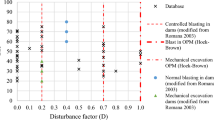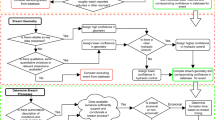Abstract
The intent of this paper is to provide overview context to allow broader understanding of conventional tailings dam failure mechanisms. The research leverages global knowledge, experience, and data collection and interpretation for the safe and controlled management of the geotechnical stability of a tailings storage facility. The motivation for this review is to facilitate transparent access to tailings dam background and understanding. This paper addresses the core understanding of geotechnical failure mechanisms, and how these eventuate to instability and failure of tailings dam structures. This research focuses on foundation failure, internal erosion and piping, overtopping, seepage, seismicity, and slope instability and provides insight into what factors contribute to failure, how failure progresses due to such failure, anticipating and monitoring for the aforementioned failure modes, and designing to mitigate their risk.


















Similar content being viewed by others
Data Availability
Not applicable.
References
Australian Government Department of Industry Tourism and Resources (2007) Tailings management: Leading Practice Sustainable Development Program for the Mining Industry. Canberra. Viewed 16 March 2017. https://www.industry.gov.au/data-and-publications/leading-practice-handbook-tailings-management
Australian National Committee on Large Dams (ANCOLD) (2003) Guidelines on dam safety management.
Australian National Committee on Large Dams (ANCOLD) (2012) Guidelines on tailings dams – planning design, construction, operation, and closure.
Azam S, Li Q (2010) Tailings dam failures: a review of the last 100 years. In: Geotechnical News: Waste GEOtechnics, pp 50–53
Boulanger RW, Idriss IM (2006) Liquefaction susceptibility criteria for silts and clays. J Geotech Geoenviron 132(11):1413–1426
Briaud JL (2008) Case histories in soil and rock erosion: Woodrow Wilson Bridge, Brazos River Meander, Normandy Cliffs, and New Orleans Levees. J Geotech Geoenviron 134(10):1425–1447
Briaud JL, Chen HC, Govindasamy AV, Storesund R (2008) Levee erosion by overtopping in the New Orleans during the Katrina Hurricane. J Geotech Geoenviron 134(5):618–632
Clarkson L, Williams D (2019) Critical review of tailings dam monitoring best practice. Int J Min Reclam Environ. https://doi.org/10.1080/17480930.2019.1625172
Davies, M, Martin, D & Lighthall, P (2002a) Mine tailings dams - when things go wrong
Davies M, Mcroberts E, Martin T (2002) Static liquefaction of tailings – fundamentals and case histories.
Davies MP, Lighthall PC, Rice S, Martin TE (2002b) Design of tailings dams and impoundments. In: Proceedings of the Tailings and Mine Waste Practices. SME, Phoenix
Davies MP, Rice S (2001) An alternative to conventional tailings management – “dry stack” filtered tailings. In: Proceedings of Tailings and Mine Waste 2001, Fort Collins, pp 411–420
Díaz-Rodrigues, López-Molina (2008) Strain thresholds in soil dynamics. In: Proceedings of the 14th World Conference on Earthquake Engineering, Beijing
Engels J (2016) Water management considerations for conventional storage, viewed 16 March 2017, http://www.tailings.info/technical/water.htm
Fannin RJ, Slangen P (2014) On the distinct phenomena of suffusion and suffosion. Géotechnique 4(4):289–294
Federal Emergency Management Agency (FEMA) (2014) Technical manual: overtopping protection alternatives for dams.
Fell R, MacGregor P, Stapledon D, Bell G, Foster M (2015) Geotechnical engineering of dams¸ 2nd edn. CRC Press/ Balkema, The Netherlands
Gibson G, Sandiford M (2013) Seismicity and induced earthquakes. Office of the NSW Chief Scientist and Engineer.
Holtz RD, Kovacs WD (1981) An introduction to geotechnical engineering. Prentice Hall, Englewood Cliffs, New Jersey
Huzjak RJ, Prochaska AB (2012) Bedrock settlement beneath a large embankment dam. In: Proceedings of the Biennial Geotechnical Seminar 2012. American Society of Civil Engineers
ICOLD (2001) Tailings dams. Transport. Placement. Decantation. Review and recommendations. International Commission on Large Dams. Bulletin 101.
IDV Solutions (2012) Earthquakes since 1898, viewed 12 February 2017, http://uxblog.idvsolutions.com/2012/06/earthquakes-since-1898.html
Jantzer I (2009) Critical hydraulic gradients in tailings dams: Comparison to natural analogies, Licentiate Thesis, Luleå University of Technology, Sweden.
Klohn EJ (1979) Seepage control for tailings dams. In: Tailings and waste disposal-seepage, contamination, regulations, and control, British Columbia, Canada
Leonards GA (1982) Investigation of failures. Sixteenth Terzaghi Lecture. ASCE J Geotech Eng 108(Number GT2, February):224–283
Liang JZ, Elias D (2010) Seismic evaluation of tailings storage facility. Australian Earthquake Engineering Society, Perth
Martin TE (2002) Characterisation of pore pressure conditions in upstream tailings dams.
Mokhtari M, Dehghani M (2012) Swell-shrink behavior of expansive soils, damage and control. Electron J Geotech Eng (EJGE) 17:2673–2682
Narita K (2000) Design and construction of embankment dams. Aichi Institute of Technology, Toyota
Nelson SA (2013) EENS 3050: slope stability, triggering events, mass movement hazards, Online Course Notes, Tulane University, Louisiana, United States.
Oancea D (2007) Man-made earthquakes, viewed 12 February 2017, http://technology.infomine.com/articles/1/887/earthquake.geothermal.energy/man-made.earthquakes.aspx
Olson Engineering (2005) Geophysical methods, viewed 19 March 2017 http://www.olsonengineering.com/methods/geophysical-methods.html
Pabst MW, Engemoen WO, Hanneman DL, Redlinger CG, Scott GA (2012) Heave, uplift, and piping at the toe of embankment dams: A new perspective. In: Proc., Dam Safety 2012. ASDSO, Denver
Richardson E (2016) Plate tectonics and intra-plate earthquakes, viewed 12 February 2017, https://www.e-education.psu.edu/earth501/content/p4_p4.html
Robertson AM (2015) FMEA risk analysis: failure modes and effects analysis. PowerPoint slides.
Shoji Y, Tanii K, Kamiyama M (2004) The duration and amplitude characteristics of earthquake ground motions with emphasis on local site effects. In: Proceedings of the 13th World Conference on Earthquake Engineering, Vancouver B.C, Canada
Szymanski MB, Davies MP (2004) Tailings dam design criteria and safety evaluations at closure, In: Proceedings of the British Columbia Reclamation Symposium 2004, British Columbia.
Task Committee on Instrumentation and Monitoring Dam Performance (2000) Guidelines for instrumentation and measurements for monitoring dam performance. Reston, Va. American Society of Civil Engineers.
The Seismology Research Centre (n.d.) Dams & earthquakes, ESS Earth Sciences, viewed 21 April 2018, http://www.src.com.au/earthquakes/seismology-101/dams-earthquakes/
U.S. Army Corps of Engineers (USACE) (2003) Slope stability, in Engineer manuals. EM 1110-2-1902. Washington, D.C.
U.S. Bureau of Reclamation, U.S. Army Corps of Engineers, University of New South Wales, and URS (2008), Risk analysis for dam safety – a unified method for estimating probabilities of failure of embankment dams by internal erosion and piping guidance document, Version D, Issue 2
U.S. Bureau of Reclamation (USBR) (2015) Internal erosion risks for embankments and foundations, in Best practice and risk methodology, Security, Safety, and Law Enforcement Office – Dam Safety.
U.S. Bureau of Reclamation (USBR) (2015b) Embankment slope instability, in Best practice and risk methodology, Security, Safety, and Law Enforcement Office – Dam Safety.
U.S. Department of Interior Bureau of Reclamation (USBR) (2011) Design standards no. 13: chapter 5 – protective filters, DS-13(5)-9.
U.S. Environmental Protection Agency (US EPA) (1994) Design and evaluation of tailings dams, technical report code EPA 530-R-94. US EPA, Washington, DC
Vucetic M (1992) Soil properties and seismic response. In: Proceedings of the 10th World Conference of Earthquake Engineering, Rotterdam, Netherlands, pp 1199–1204
Woodward J (2005) An introduction to geotechnical processes. Spon Press, New York, New York.
Yuen STS (n.d.) Introduction to foundation engineering, The University of Melbourne, viewed 10 April 2017, http://people.eng.unimelb.edu.au/stsy/geomechanics_text/Ch13_foundatn.pdf
ZagonJolli M (2007) Dam break modelling, risk assessment and uncertainty analysis for flood mitigation, PhD thesis, Delft University of Technology, the Netherlands.
Zhao G (2016) Breach growth in cohesive embankments due to overtopping. Delft Academic Press, Delft
Zhang L, Peng M, Chang D, Xu Y (2016) Dam failure mechanisms and risk assessment, 1st edn. John Wiley & Sons, Singapore
Acknowledgements
The authors would like to recognise The University of Queensland and the Geotechnical Engineering Centre for the opportunity to explore this field and dedicate best efforts forward to empower others to achieve their potential in tailings dam safety. The authors would like to acknowledge GroundProbe for their technical and financial contributions to this Doctor of Philosophy and for upholding a genuine interest in safety over commercials. GroundProbe provided financial support for the conduct of the research, which supported the research through facilitation of international collaboration with the geotechnical community of practice, enhancing the perspectives and understanding as expressed in this research. The authors would like to acknowledge The Mining and Geotechnical community that the authors have made a network with as part of this work, particularly those involved in Tailings and Mine Waste 2017, and Slope Stability 2018, as well as from The University of Queensland and the Australian Government, for their influential and wide perspectives on global practice and how safety can be improved. The author would also like to recognise those that support unconditionally, irrespective of the degree of involvement in this work. Such positive attitudes and perspectives are interpersonal fuel to driving value in the technical setting.
Funding
This research was supported by GroundProbe, through a PhD grant awarded to the primary author, Luke Clarkson.
Author information
Authors and Affiliations
Contributions
In alignment with the Contributor Roles Taxonomy (CRediT) methodology:
Luke Clarkson: conceptualisation, methodology, data curation, investigation, writing—original draft, verification, writing—review and editing
David Williams: project administration, supervision
Corresponding author
Ethics declarations
Conflict of Interest
The authors declare that there is no conflict of interest.
Code Availability
Not applicable.
Additional information
Publisher’s Note
Springer Nature remains neutral with regard to jurisdictional claims in published maps and institutional affiliations.
Rights and permissions
About this article
Cite this article
Clarkson, L., Williams, D. An Overview of Conventional Tailings Dam Geotechnical Failure Mechanisms. Mining, Metallurgy & Exploration 38, 1305–1328 (2021). https://doi.org/10.1007/s42461-021-00381-3
Received:
Accepted:
Published:
Issue Date:
DOI: https://doi.org/10.1007/s42461-021-00381-3




